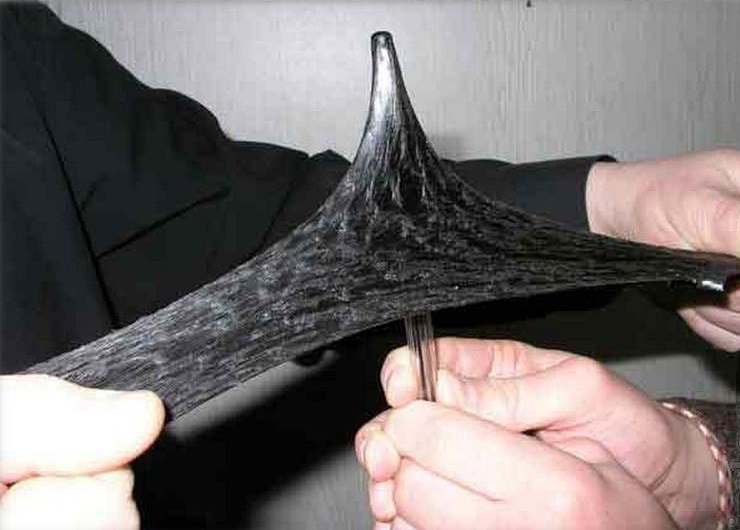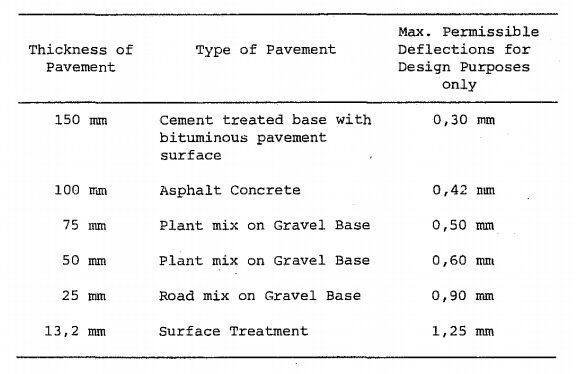
RUBBERIZED BITUMEN

INTRODUCTION OF RUBBERIZED BITUMEN
The introduction of rubber into bitumen binders is not a new concept. It has been extensively used in the U.S.A., Australia, and Europe for quite a number of years with effective results, which cannot be lightly ignored. In South Africa the use of latex in emulsion has also been effectively used in various ways for the last 10-15 years, but the introduction of scrap rubber into hot bitumen has only recently been done and it might serve some purpose to review the situation in order to obtain a balanced and practical assessment of the efficiency of this relatively new product in this country.
THE BITUMEN RUBBER SEAL
Extraordinary claims have been made in various publications that rubberized bitumen seals can not only inhibit but also cure reflective cracking, thermal cracking f fatigue cracking I pumping and various other types of cracks. Before embarking on a programme of rubberized bitumen seal on any project it is advisable to determine and define the problems, e. g. if there is no base or subbase failure, but the surface layer has dried out or there is too little binder in the surfacing, a crocodile pattern of cracking on the surface could obtain. These cracks could be classified as IIdocilell or passive cracking of the surface.
Conversely, I where movement due to changes in temperature, change in moisture content of the underlying layers, differential movement due to wheel-loads, takes place, these cracks could be classified as “active” cracks.
It has been our experience in the field that seals coats applied over surfaces containing “active” or potentially “active” cracks when sealed with straight bitumen seals, only last for some 18 months to 24 months before the same conditions are again apparent on the surface.
On the other hand, if passive cracks are pretreated and sealed with straight bitumen, the life of the new seal could last up to 12 years or longer, depending on the traffic. Therefore, under these conditions, rubberized bitumen seals would not normally be applied. Where would rubberized bitumen seals be considered for maintaining a road surface?
(i) On heavily trafficked surfaces, where difficulty is
anticipated in applying sufficient binder to .hold the aggregate without introducing the problem of bleeding.
(ii) Where movement of the base, subbase or subgrade layers could take place due to moisture movement. If it were possible to seal the surface and inhibit the ingress of water into the pavement layers, this could more effectively be done with a rubberized bitumen seal by virtue of the fact that some 50% more binder could be used than straight bitumen binder.
(iii) On pumping surfaces. Although it has been claimed that bitumen rubber seals will solve this problem, the best that can be said is that it will inhibit pumping but not solve the problem in all cases. Large hydraulic pressures are generated by pavement layers – disintegrate. heavy sufficient wheel-loads on saturated to cause pavements to disintegrate.
(iv) The primary cracking in cement stabilized pavements, especially the longitudinal cracks, form ideal catch-water drains for water to enter the pavement layers. Normally the subbase is a lime or cement stabilized layer – an ideal seal to box in the water ready for hydraulic pressures to be generated by heavy wheel-loads. In these cases, there is a fair amount of movement due to temperature changes as well as to wheel-loads on the pavement.
Before sealing the road these cracks must be treated – preferably with bitumen rubber compounds.
Many of the asphalt surfaces placed over these stabilized pavements are porous and during wet spells, large volumes of water are virtually pumped through the surface by the heavy wheel-loads.
A combination of crack sealing and the sealing of the
surface using bi turned rubber seals would certainly extend the life of a pavement. The sealing of the surface with a bitumen rubber seal, however, I am not always necessary if the primary crack sealing is timeously and properly done and the vehicle count is not excessive, e.g. 15 000 v.p.d./lane width.
(v) Where one has bleeding but stable surfaces, i.e. where the surface bitumen is not so thick that the surface is unstable and should be removed, bitumen rubber seals can be effectively used.
RUBBERISED ASPHALT
Ever since the extensive use of asphalt surfaces in South Africa, there has been an ongoing problem in various areas of obtaining an economic life out of such surfaces.
The three main asphalt surfaces that have been used in South Africa are:
(a) Continuously graded aggregate asphalt.
(b) The gap-graded or semi gap-graded aggregate asphalt.
(c) The “popcorn” wearing course.
(a) One of the main causes of distress in the asphalt surfaces (a) and (b) is that the pavement deflections obtaining in the field exceed the deflection that the asphalt layer will tolerate. Quoting from Hveem’s work in the California Highway Department, we have the following information:

The above limiting deflections put the problem in its correct perspective.
(b) Most asphalt overlays are to a lesser or greater. extent porous. Once water can fill the voids in a surface, during continuous wet weather, under heavy wheel-load traffic, hydraulic forces come into action and deterioration of the surface can take place. The wheel-loads virtually start pumping the water into or through the surface. The situation can be aggravated if the aggregate has a low affinity for bitumen – e.g. our quartzites in the Transvaal. Very little work has been done in freezing conditions in South Africa but we do specify a minimum void content in our asphalts to obviate bleeding on our asphalt surfaces. At the same time, we have measured minimum temperatures of –7°C in the Free State, fortunately under dry conditions.
There are two problems that occur with “popcorn” surfaces.
(i) Either the surface tends to close up due to too much binder, or
(ii) the surface starts ravelling due to too little binder.
In the latter case, the ravelling takes place due to stripping cf the binder from the aggregate. In the former case, the bitumen tends to flow and there is a reorientation of the’ aggregate due to the lubricating effect of the binder. The introduction of rubber into bitumen has to a very large extent overcome t.he above problems.
From tests that have been done to date, the following results have been obtained and the following conclusions reached.
When comparing the Instron Beam Fatigue Test on a gap-graded BSS 594 asphalt with the same test done on an open graded (not popcorn) asphalt, the results are as follows:
Rubberised asphalt (open graded) 500 000 repetitions
tested at 20 C (No failures)
Semi gap-graded 60/70 bitumen Failed at 70 000
tested at 20 C repetitions
The stability of the rubberized open graded asphalt was 7,7 KN with a flow of 2,8 mm with 7% bitumen and 2,4% rubber. The immersion indices are substantially higher than those normally encountered with quartzitic aggregates and figures of 92 to 98 have been obtained. Several sections have been laid on Roads P29/2, P157/2, and P2/1.
Doubt has been expressed about the material possibly rutting under traffic. A similar specification was used by Rebecci of the Victoria Road Construction Authority, Australia, on an overlay in an urban area on a concrete road carrying 30000 to 40000 v.p.d.
This was laid 30 mm thick and after four years of use –
(a) there was no rutting and
(b) less than 10% of the joints had very fine insignificant hair cracks.
The deflection at the joints of this concrete pavement before overlaying, varied between 0,2 to 0,8 mm. Evidence of thermal cracking in the shoulders was not apparent except for a few minor insignificant hair cracks at the joints.
The high immersion indices obtained are most significant as this index is a measure of possible stripping that could take place. Secondly, from the extensive Reidel & Weber tests, we have done excellent results have been obtained with rubberized bitumen as far as stripping is concerned.
The problem of excess binder flowing off the aggregate at high temperatures was investigated specifically fur t.he use of bitumen rubber for the popcorn mix. The sample of “popcorn” rubberized asphalt was placed in the oven for two hours at 2000 C and there was no apparent flow of the binder to the bottom of the pan. This is an important check to carry out as the asphalt must be stored at a high temperature for the rubber to digest before laying. The Marshall test is not applicable to “popcorn” asphalts but for comparative purposes only, this’ test was done and with higher percentages of binder almost twice the stability was obtained using rubberized bitumen than when using the normal percentage of neat bitumen.
So where is rubberized asphalt suitable for cost-effective use?
(a) Firstly the extra cost of rubberized asphalt is of the order of 10-15% more than ‘normal asphalt.
(b) Since the S.A.T.S’ relaxation on permits for road haulage, there has been a steady increase not only in the number of ESO’s using our road system but there has also been a greater occurrence of overloaded vehicles using the system. Many of our roads have been surfaced with thin carpets, e.g. double seals, Cape seals, 25 mm and 50 mm asphalt surfaces.
It was standard practice in the U.S.A. to use nothing less than 100 mm of asphalt concrete on heavily trafficked roads.
with the increased wheel-loads and intensity of loading, there will be an increased magnitude of deflections of the pavement as well as an increase in the repetition of these greater deflections.
The country simply cannot afford to rebuild its network to carry this increased transport burden.
By investigating the deflections obtaining on certain roads, it will be possible to overlay these roads with thin rubberized asphalt carpets which can withstand repetitive higher deflections than with the normal asphalts currently in use. The problem currently experienced with “popcorn” surfaces can probably effectively be overcome.
CONCLUSION
(a) Asphalt
There are a few precautions that must be exercised in the production of rubberized asphalt:
(i) The quality and grading of the rubber additive must be controlled.
(ii) The quantity of rubber must be controlled.
(iii) The digestion time and temperatures must be controlled.
(iv) The Use of additives, e.g. paraffin or extender oils must be avoided.
(b) Rubberized Seals
Rubberized bitumen seals should only be used where they will be most effective and where they will solve problems which normal seals cannot effectively do. The cost of a rubberized seal at this stage is approximately 50% more than that of a normal seal. Therefore, if a single seal lasts eight years, the rubberized seal should last approximately 12 years to be cost-effective on a road with no specific problems.
Advantages of
Higher resistance to deformation and increased Road temperature enhances smooth drive comforts.
Improved adhesion and bonding with aggregates, Higher Softening Point, High Flow resistance and Higher Impact Resistance to withstand movement of Heavy Vehicle Traffic.
Higher Skid Resistance, Better Road Grip, and smoother vehicle break application reduce accident chances substantially.
Higher elongation and Tensile strength increase elasticity, reduced Thermal Sensitivity reduces the chances of all types of cracks under stress.
Reduces degree of rutting, improves driving comfort even on Higher Axle Load.
Higher Anti-Stripping properties and highly resistant to moisture/water absorption reduce the chance of damage of roads during heavy rain even under improper drainage.
Higher aging resistance due to passivity to oxidation (Resist degradation on high application temperature as well as during summer ensures longer life of pavement with lesser maintenance).
ADVANTAGES OF RUBBERIZED BITUMEN
- Higher resistance to deformation and increased Road temperature enhances smooth drive comforts.
- Improved adhesion and bonding with aggregates, Higher Softening Point, High Flow resistance and Higher Impact Resistance to withstand movement of Heavy Vehicle Traffic.
- Higher Skid Resistance, Better Road Grip, and smoother vehicle break application reduce accident chances substantially.
- Higher elongation and Tensile strength increase elasticity, reduced Thermal Sensitivity reduces the chances of all types of cracks under stress.
- Reduces degree of rutting, improves driving comfort even on Higher Axle Load.
- Higher Anti-Stripping properties and highly resistant to moisture/water absorption reduce the chance of damage of roads during heavy rain even under improper drainage.
- Higher aging resistance due to passivity to oxidation (Resist degradation on high application temperature as well as during summer ensures longer life of pavement with lesser maintenance).
